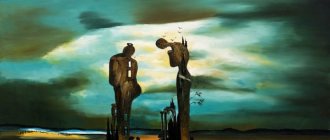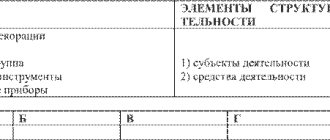At birth, a person is not yet a person, but is gradually transformed into one, assimilating information about the world around him and forming his own views about it. Skills such as learning ability, assimilation, processing of received data and their critical evaluation help people develop a system of intellectual and emotional assessment of reality.
Put together principles, ideals and views of the world, supported by actions corresponding to them, constitute the essence of a person’s worldview. The summation of all the components of the system is the spiritual and practical activity of the individual.
Vision of the world
A person’s system of views on the surrounding reality and his ability to master it, his ethical values, the generalization of the natural scientific, technical, philosophical and other knowledge at his disposal, this is what a worldview is.
The term was first introduced in the late 18th century to mean “view of the Universe” by the German philosopher Kant. Only from the second half of the 19th century. it began to mean a system based on judgments about the world and the place that a person occupies in it.
In fact, this concept means the complex interaction of various blocks of knowledge, beliefs, emotions, thoughts and moods, combined into a kind of understanding by people of the surrounding reality and themselves in it.
Each individual, having his own set of opinions and views on reality, can unite in groups, communities, families or other organizations with people with similar judgments. Depending on what values, points of view or life programs determine their consciousness, nations, various layers of society, an intellectual or social elite, or classes are formed.
Development of the worldview of civilizations
Observing the phenomena occurring in nature, people since ancient times have tried to give them at least some explanation. The easiest way to do this was to declare your existence and everything around you as a manifestation of the will of the gods. Thus, a supernatural and mythical vision of what was happening was formed, which was the main one for several millennia.
The main thing that such a worldview explained was the illusory nature of life, since everything is predetermined by the gods, which most people confirmed, resigning themselves to such a view of reality. Thanks to those individuals who went against accepted wisdom (did not obey the will of the gods), history and, accordingly, the worldview changed in the minds of people and entire civilizations.
By reasoning about existing orders in natural phenomena and comparing them, people created such a science as philosophy. Thanks to the ability to cognize the surrounding reality in all its diversity, man has constantly improved the model of the Universe, the Earth and studied his place in it.
As experience in knowledge of reality accumulated and was tested in practice, sciences appeared in civilizations and their worldview changed. For example, observations of changes in the starry sky formed the basis of astrology and then astronomy.
Self-awareness and personality development
Personal self-awareness is not a quality inherent in a person at birth. It goes through a long period of evolution and improvement. However, the first beginnings of identity are observed in infancy. In general, the development of a person’s self-awareness goes through several successive stages, which can be symbolically divided into the following:
Stage 1 (up to one year) - the child separates himself from the world of people and objects. At first, he does not distinguish himself from those around him, does not distinguish his own movements from those carried out by his relatives when caring for him. Games - first with arms and legs, and then with objects of the external world, which indicate the child’s primary distinction between active and passive own roles in motor activity. This experience gives the child the opportunity to realize his own potential. The emergence and development of children's speech is of particular importance. This actually brings him into the sphere of relationships with people around him.
Stage 2 (1-3 years) – marked by intense and significant mental development. Self-awareness of a child’s personality is associated with impulses to perform actions and coordinate them over time. Contrasting yourself with others is often negative. It is from this, despite the imperfection and instability of these first forms of motivation, that the distinction of the child’s spiritual “I” begins.
Stage 3 (3-7 years) – development is smooth and even. In the third year of life, the child stops talking about himself in the third person, wants to experience his own independence and contrast himself with others. These attempts to gain independence by the individual lead to a number of conflicts with others.
Stage 4 (7-12 years) - reserves continue to accumulate, and the process of self-awareness occurs without noticeable crises and leaps. There are striking and significant changes in consciousness, associated primarily with changes in social conditions (school).
Stage 5 (12-14 years) - the child again begins to be interested in his own personality. A new crisis develops when the child seeks to be different and oppose himself to adults. Social self-awareness is clearly expressed.
Stage 6 (14-18 years) - is of particular significance, since it is here that the personality rises to a new level and itself immeasurably influences the further development of self-awareness. Finding yourself, collecting knowledge about your own identity is a paramount task. This marks the beginning of maturity.
Structure of worldview
As you know, the formation of a worldview begins at the age of two or three. By the age of seven, children have already developed a personal worldview based on the experience and practical application that they have managed to obtain and process.
The main questions characterizing human activity at any age are:
- know what he wants;
- have an idea how to achieve this;
- want exactly this;
- achieve what you want.
To understand what a worldview is, you should know what structural elements it consists of:
- cognitive - includes all scientific, social, technical, everyday and other knowledge that is known to man and together creates his universal understanding of the world;
- value-normative – includes the ideals and beliefs that underlie the actions of each individual and constitute his value system;
- moral-volitional – combines the existing system of knowledge with the emotional perception of reality and a person’s determination of his place in society, the team, the world and his attitude towards it;
- practical - the worldview is considered complete and is perceived as a guide to action, by which one can determine what values underlie it.
People may change their beliefs throughout their lives, but their core values remain constant.
Features of the mythological and religious worldview
Already in historical times, people have created ideas about the world that surrounds them, and about the forces that control both the world and man. The existence of these views and ideas is evidenced by the material remains of ancient cultures and archaeological finds. The most ancient written monuments of the Middle Eastern regions do not represent complete philosophical systems with a clear conceptual apparatus: there is neither the problem of the existence and existence of the world, nor honesty in the question of man’s ability to understand the world.
Myth is one of the forms of expression by a person of his reality at the initial stage of his relationship to the world and indirect understanding of social relations of a certain integrity. This is the first (albeit fantastic) answer to questions about the origin of the world, about the meaning of the natural order. It also determines the purpose and content of individual human existence. The mythical image of the world is closely related to religious ideas, contains a number of irrational elements, is distinguished by anthropomorphism and personifies the forces of nature. However, it also contains the sum of knowledge about nature and human society acquired through centuries of experience.
The famous English ethnographer B. Malinovsky noted that the myth about how it existed in a primitive community, that is, in its living, primordial form, is not a story told, but an experienced reality. This is not an intellectual exercise or artistic creation, but a practical guide to the actions of a primitive collective. Myth serves to justify certain social attitudes, sanction a certain type of belief and behavior. During the period of dominance of mythological thinking, the need for acquiring special knowledge had not yet arisen.
Thus, myth is not the original form of knowledge, but a special type of worldview, a specific figurative syncretic image of natural phenomena and collective life. Myth, as the oldest form of human culture, combined the rudiments of knowledge, religious beliefs, moral, aesthetic and emotional assessment of the situation. If in relation to myth we can talk about cognition, then the word “cognition” here means not the traditional acquisition of knowledge, but the perception of the world, sensory empathy.
It was also impossible for primitive man to record his knowledge and be convinced of his ignorance. For him, knowledge did not exist as something objective, independent of his inner world.
In primitive consciousness, the thought must coincide with the experience, the action with the action. In mythology, man dissolves in nature, merges with it as its inseparable particle.
The mythological form is characterized by:
- syncretism - there are no clear differences between material and spiritual phenomena;
- anthropomorphism - identification of the forces of nature with the forces of man, their spiritualization;
- polytheism (polytheism) - every natural phenomenon has its own cause - this is God. The gods have human traits and vices, but they are immortal.
The formation of the world was understood in mythology as its creation or as a gradual development from a primitive formless state, as ordering, transformation from chaos into space, as creation through overcoming demonic forces.
The main principle for solving ideological problems in mythology was genetic. Explanations of the origin of the world, the origin of natural and social phenomena were reduced to a story about who gave birth to whom. In the famous “Theogony” of Hesiod, as well as in the “Iliad” and “Odyssey” of Homer - the most complete collection of ancient Greek myths - the process of creation of the world was presented as follows. In the beginning there was only eternal, boundless, dark Chaos. It was the source of life of the world. Everything arose from boundless Chaos - the whole world and the immortal gods. The Goddess of the Earth, Gaia, also came from Chaos. From Chaos, the source of life, the powerful love that animates everything, Eros also rose.
Boundless Chaos gave birth to Darkness - Erebus and dark Night - Nyukta. And from Night and Darkness came the eternal Light - Ether and the joyful bright Day - Hemera. The light spread throughout the world, and night and day began to replace each other. The mighty blessed Earth gave birth to the vast blue sky - Uranus, and the sky stretched over the Earth. The high Mountains born of the Earth rose proudly towards him, and the endlessly noisy Sea spread wide. Sky, Mountains and Sea are born from mother Earth, they have no father. The further history of the creation of the world is connected with the marriage of Earth and Uranus - Heaven and their descendants. A similar pattern is present in the mythology of other peoples of the world. For example, we can get acquainted with the same ideas of the ancient Jews from the Bible - the Book of Genesis.
Myth usually combines two aspects - diachronic (telling about the past) and synchronic (explaining the present and future). Thus, with the help of myth, the past was connected with the future, and this provided a spiritual connection between generations. The content of the myth seemed to primitive man extremely real, deserving of absolute trust.
Mythology played a huge role in the lives of people in the early stages of their development. Myths, as noted earlier, affirmed the value system accepted in a given society, supported and sanctioned certain norms of behavior. And in this sense they were important stabilizers of social life. This does not exhaust the stabilizing role of mythology. The main meaning of myths is that they established harmony between the world and man, nature and society, society and man, and thereby ensured the internal harmony of human life.
The practical significance of mythology in the worldview has not yet been lost. Both Marx, Engels, Lenin, and supporters of opposing views - Nietzsche, Freud, Fromm, Camus, Schubart - in their works resorted to images of mythology, mainly Greek, Roman and a little ancient German. On a mythological basis, the first historical type of worldview is distinguished, which is now preserved only as an auxiliary one.
In the early stages of human history, mythology was not the only form of worldview. Religion also existed during this period. Close to the mythological worldview, although different from it, was the religious worldview, which developed from the depths of the still undifferentiated, undifferentiated social consciousness. Like mythology, religion appeals to fantasy and feelings. However, unlike myth, religion does not “mix” the earthly and the sacred, but in the most profound and irreversible way divides them into two opposite poles. The creative omnipotent force - God - stands above and outside of nature. The existence of God is perceived by man as a revelation. As a revelation, a person is given to know that his soul is immortal, eternal life and a meeting with God await him beyond the grave.
For religion, the world has a rational meaning and purpose. The spiritual principle of the world, its center, a special landmark among the relativity and fluidity of the diversity of the world is God. God gives integrity and unity to the whole world. He directs the course of world history and establishes moral sanction for human actions. And finally, in the person of God, the world has a “highest authority,” a source of strength and help that gives a person the opportunity to be heard and understood.
Religion, religious consciousness, religious attitude towards the world did not remain vitally important. Throughout the history of mankind, they, like other cultural formations, have developed and acquired various forms in the East and West, in different historical eras. But all of them were united by the fact that at the center of any religious worldview is the search for higher values, the true path of life, and that both these values and the life path leading to them are transferred to the transcendental, otherworldly realm, not earthly, but to the “eternal” life. All a person's deeds and actions and even his thoughts are evaluated, approved or condemned in accordance with the highest, absolute criteria.
First of all, it should be noted that the ideas embodied in myths were closely intertwined with rituals and served as an object of faith. In primitive society, mythology was in close interaction with religion. However, it would be wrong to say unequivocally that they were inseparable. Mythology exists separately from religion as an independent, relatively independent form of social consciousness. But in the earliest stages of the development of society, mythology and religion formed a single whole. From a content point of view, that is, from the point of view of ideological constructs, mythology and religion are inseparable. This does not mean that some myths are “religious” and others are “mythological.” However, religion has its own specifics. And this specificity does not lie in a special type of ideological structures (for example, those in which the division of the world into natural and supernatural predominates) and not in a special attitude towards these ideological structures (an attitude of faith). The division of the world into two levels is inherent in mythology at a fairly high stage of development, and the attitude of faith is also an integral part of mythological consciousness. The specificity of religion is due to the fact that the main element of religion is a system of cults, that is, a system of ritual actions aimed at establishing certain relationships with the supernatural. And therefore, any myth becomes religious insofar as it is included in the system of cult and acts as its content side.
Worldview constructions, entering the system of cults, acquire the character of a doctrine. And this gives the worldview a special spiritual and practical character. Worldview constructs become the basis for formal regulation and regulation, ordering and preservation of morals, customs, and traditions. With the help of rituals, religion cultivates in people feelings of love, kindness, tolerance, compassion, mercy, duty, justice, etc., giving them special value, connecting their presence with the sacred, supernatural.
The main function of religion is to help a person overcome the historically changeable, transitory, relative aspects of his life and raise a person to something absolute, eternal. From a philosophical point of view, religion is intended to “root” man in the transcendental. In the spiritual and moral sphere, this is manifested in giving norms, values and ideals an absolute, unchanging character, independent of the conjuncture of the spatio-temporal coordinates of human existence, social institutions, etc. Thus, religion gives meaning and knowledge, and therefore the stability of human existence, helps him overcome everyday difficulties.
With the development of human society, the establishment of certain patterns by man, and the improvement of the cognitive apparatus, the possibility of a new form of mastering ideological problems has emerged. This form is not only spiritual and practical, but also theoretical. The image and symbol are replaced by Logos - reason. Philosophy is born as an attempt to solve basic worldview problems with the help of reason, that is, thinking based on concepts and judgments that are interconnected according to certain logical laws. In contrast to the religious worldview, with its primary attention to issues of man’s relationship to forces and beings superior to him, philosophy has highlighted the intellectual aspects of the worldview, reflecting the growing need for society to understand the world and man. knowledge point of view. It originally entered the historical arena as a quest for worldly wisdom.
Philosophy inherited from mythology and religion their ideological character, their ideological schemes, that is, the whole complex of questions about the origin of the world as a whole, its structure, the origin of man and his position in the world, etc. He also inherited the entire volume of positive knowledge, which humanity has accumulated over thousands of years. However, the solution to ideological problems in the emerging philosophy occurred from a different point of view, namely from the point of view of rational assessment, from the point of view of reason. Thus, we can say that philosophy is a theoretically formulated worldview. Philosophy is a worldview, a system of general theoretical views on the world as a whole, on the place of man in it, an understanding of the various forms of man’s relationship to the world, man to man. Philosophy is a theoretical level of worldview. Consequently, the worldview in philosophy appears in the form of knowledge and is systematized, ordered. And this moment, in fact, brings philosophy and science closer together.
The essence of worldview
The main condition for the development of the human personality is the constant study of the surrounding reality, the changes occurring in it and adaptation to them.
To understand what the essence of a worldview is, one should consider the levels of which it consists:
- Attitude is the ability of people to adapt to the environment and navigate it. At this level, knowledge of the world is carried out through the 5 senses and the work of the unconscious. This is also where the emotional assessment of reality is located. For example, an unexpected feeling of joy and happiness arises at the unconscious level before the brain begins to look for the reason that led to such a change in mood.
- Understanding the world is work at the level of consciousness, during which information about the surrounding reality is received and processed. During this process, 2 types of perception appear:
- Ordinary, during which a person forms his opinion about the desired standard of life, people around him, work, country, politicians, family relationships and much more.
- The theoretical type is a general knowledge of existence, one’s place in the world, based on the available data of various sciences or philosophy.
The essence of a worldview is to bring all levels of perception of reality into a single system of values, knowledge and their emotional assessment into a certain life position, confirmed by human actions.
Signs
An ordinary worldview is a form that is formed on the basis of acquired knowledge, emotional experiences, analysis of incoming information, which predetermines the individuality of established views. A characteristic feature of the everyday worldview is the development of judgments and ideas based on the emotional and sensory perception of the surrounding world.
The signs of an everyday worldview include the dominant influence of beliefs, customs and traditions formed in society. A feature of the everyday worldview is the leading influence of the individual’s personal experience, which accumulates as a result of daily cognitive and practical activity. Other factors influencing the formation and development of a belief system:
- Collective opinion and public experience.
- Stereotypical ideas about the rules of behavior, norms of interpersonal relationships.
- Legends, superstitions, prejudices that form the basis of folk wisdom.
Everyday individual experience helps to navigate the present, for example, to cope with life's difficulties. A person, encountering obstacles in achieving goals, analyzes the situation, determines the consequences, identifies the problem, and finds ways to eliminate it. Other functions of ordinary experience:
- Identifying real prospects when planning actions.
- Forecast of developments.
- The direction of the activity vector is in accordance with the goals set.
Collective experience determines the emergence of archetypes - images that unite collective character traits. A person endowed with the properties of an archetype does not exist in nature. It is an ideal that represents the aspirations and hopes of people. The everyday worldview is associated with the appearance of the archetypes of the hero-liberator, mother, wise old man, prophet - predictor of the future. Signs of an ordinary worldview:
- Autonomy. Attitudes that have arisen within the framework of a system of views are independent and independent in the general structure of the worldview. For example, systems of education, family values, and the creation of living conditions exist independently of each other.
- Associativity. An individual adopts experience accumulated over centuries and acts associatively with the examples of ancestors and other people.
- Integration of diverse knowledge. The belief system is built on knowledge that covers all areas of life.
- Fragmentation. An individual perceives and assimilates information that he considers interesting and useful.
In the process of creating an everyday worldview, a thinking person combines in his consciousness fragments of knowledge from different spheres of life, including from the code of ethics, science, politics, and culture. Formulated ideas about life help you choose meaningful goals, achieve them, avoid social conflicts and mistakes, and overcome difficulties. A person in everyday conditions perceives and evaluates his personality, shows an attitude towards nature and the people around him.
Main types
The theoretical basis of the worldview is philosophy, and the practical basis is the spiritual integrity of man, confirmed by his activities. Conventionally, it can be divided into several types:
- Archaic is a period when humanity perceived the world as alive and interacted with it based on this knowledge. This type is characterized by totemism, one of the properties of which was people’s identification with animals, birds or natural phenomena.
- The next level of development is the mythological type of worldview, according to which everything visible and invisible tends not only to have an image, but also to interact with a person and with each other. People communicate with the gods, make sacrifices to them, pray, build temples, observe rituals, and may even compete or oppose them.
- The religious type separates man from the world of spirits. There are no gods on Olympus, but people have not lost faith in them. Other rituals, dogmas, commandments appeared, but the authority of the gods was undeniable.
- The philosophical type is based on critical consciousness, which does not accept old postulates on faith, but requires their logical confirmation.
Each type of worldview had its own principles. Depending on changing views on the surrounding reality, all eras have their own values.
Features of personality self-awareness
The concept of personal self-awareness in psychology is a voluminous, multi-level process and contains stages, functions and structure. It is customary to consider four stages: cognitive (the simplest self-knowledge and self-awareness of the processes and mental states of the body); personal (self-esteem and experience in connection with one’s strengths and weaknesses); intellectual (self-analysis and introspection); and behavioral (symbiosis of the previous stages with motivated behavior). There are theories in which the development of a person’s self-awareness contains only two phases: passive and active. In the first phase, the individual’s self-awareness is an automatic consequence of development, and in the second it is activated and determines this process.
The main functions include: self-knowledge - obtaining information about oneself; emotional-integral self-relation and formation of “I”; self-defense of your unique personality; self-regulation of behavior.
A person's self-awareness is genetically predetermined to a large extent. The child is aware of himself, personal qualities, distinguishes himself from others, so the world around him gradually forms self-awareness. Its development repeats the periods of formation of one’s own knowledge about the objective world. Then this process moves to a higher path of development, in which, instead of sensations, processes of comprehension appear in conceptual form.
The main feature and most important component of self-awareness is the image of “I”. These are relatively stable and not always conscious concepts of a person about himself, as a result of which he interacts with people. This image acts as an attitude directly towards one’s actions and includes three components: cognitive, behavioral and evaluative. The first includes the concept of one's appearance, abilities and social significance. The second component covers the desire to be understood and to earn the respect and sympathy of friends, teachers or colleagues. And the third unites his own respect, criticism and humiliation.
There is also an ideal “I”, which denotes the desired vision of oneself. This image is inherent not only in adolescence, but also in more mature age. The study of self-esteem helps to determine the degree of destructiveness or adequacy of the “I”.
Basic principles
The main principles of the worldview concern the relationship of God with the world and are divided into:
- Atheism is the denial of the existence of the supernatural and gods, and the fundamental principle of everything is matter, the study of which is possible only in a sensual way.
- Skepticism - the principle is based on doubts about the immutability of truth and the denial of the divine destiny of man and the meaning of his life. People who share these views believe that the individual is obliged to determine his own destiny, the main values of whose worldview should be to achieve the maximum amount of pleasure.
- Pantheism is the belief in a certain basis of the world that gave birth to all things. The form of studying reality in pantheism is observation of reality and deduction on the physical level, and mystical intuition on the spiritual.
- Creationism is a principle that affirms God as the first cause of everything, but separates the components that underlie the world from the nature of the Creator himself.
Summarizing what a worldview is, we can define that it is the totality of all knowledge, feelings, views and assessments of a person’s reality in his understanding of the world.
Self-awareness and self-esteem of the individual
The stimulus for personal development is self-esteem. It is an emotionally charged assessment of the image of “I”, which consists of the subject’s concepts about his activities, actions, his own strengths and weaknesses. In the process of socialization of a person, the ability to self-esteem is formed. This happens gradually, as a personal attitude to actions is revealed, based on the assessments of others and the assimilation of moral principles developed by society.
Self-esteem is divided into adequate, underestimated and overestimated. People with different types of self-esteem in the same situations can behave completely differently. They will influence the development of events in every possible way, taking radically opposite actions.
Inflated self-esteem occurs in people with an idealized idea of their importance to others and the importance of personality and value. Such a person is filled with pride and pride, and therefore never admits his own knowledge gaps, mistakes or unacceptable behavior. He is lazy and often becomes aggressive and tough.
Very low self-esteem is characterized by shyness, lack of self-confidence, shyness and failure to realize one’s talents and skills. Such people are usually overly critical of themselves and set goals lower than those they could achieve. They exaggerate personal failures and cannot do without the support of others.
Active, energetic and optimistic people develop adequate self-esteem. She is distinguished by a reasonable perception of her own abilities and capabilities, a rational attitude towards failures about the appropriate level of aspirations.
For self-esteem, self-esteem also plays an important role, that is, a personal opinion about oneself, regardless of the opinions of other people, and the level of a person’s competence in a strong area.
Existing problems
The main problem of worldview is the contradictions in people's views on existing reality. Each individual sees it through his own lens of perception, which focuses on beliefs and basic life attitudes, confirmed in practice. It's the difference in what people focus on that makes them so different.
For example, those who focus on money accumulate capital, those who focus on their absence create poverty.
The influence of worldview on the level and quality of life of people has been proven experimentally. As soon as a person changes his beliefs and focuses on new attitudes (wealth, health, love, career and much more), the picture of the world begins to gradually change.
It is important to remember that the problem with change is the time lag. If a person has believed for a long time that he cannot become rich, then it will take some time for new views of the worldview to “take root” in the subconscious.
Spiritual aspect
It used to be that people were individuals who had spiritual experiences throughout their lives. Modern sciences come to the conclusion that man is a spirit gaining experience in a physical body. Today, more and more attention is being paid to studying the relationship between the Creator and his creation.
The spiritual worldview of people is built on the acceptance or denial of God. Harmony is based on:
- love for the world in general;
- acceptance of current events as a manifestation of divine will;
- connecting to the energy of love through prayer;
- realization of one’s own life through its harmonious living;
- a balanced state in all areas of life.
In the absence of spiritual development, people are filled with resentment, adversity, illness and misunderstanding of the meaning of life.
Worldview today
The global community that exists today is integrated across the entire planet. The modern worldview of man includes the sum of knowledge of all available sciences at the level of a non-specialist. It is based on the knowledge of reality through the 5 senses with further processing of information by the mind.
From the data received, a person builds his own picture of the world, which he can consciously influence and modify. The only thing that has remained unchanged is man's purpose. She is still in the knowledge of the world and place in it.











